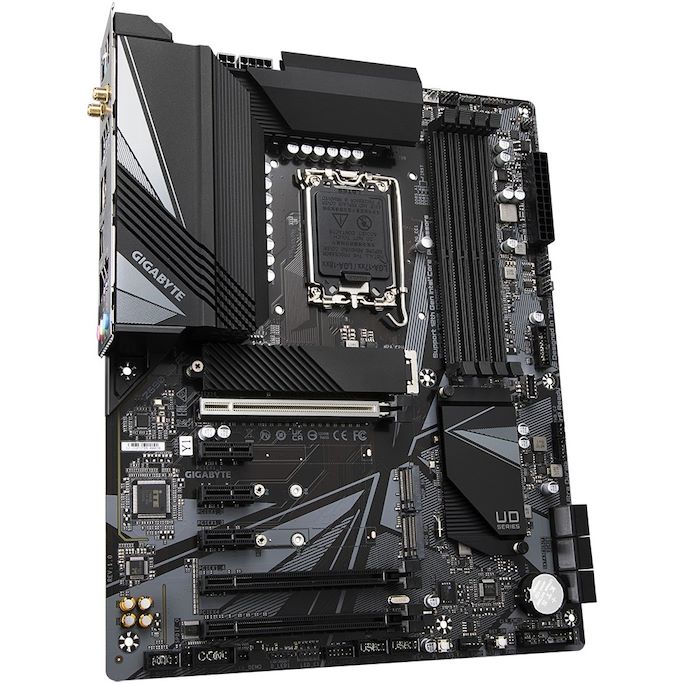The Intel Z690 Motherboard Overview (DDR5): Over 50+ New Models
by Gavin Bonshor on November 9, 2021 9:00 AM ESTGIGABYTE Z690 UD AX, Z690 UD AC & Z690 UD (DDR5)
Moving onto GIGABYTE's entry-level Z690 models with support for DDR5 memory, we have three near-identical representatives from its Ultra Durable series (UD). All three GIGABYTE Z690 UD models feature the same black and grey aesthetic, as well as the same core feature set. The only difference between the three comes in the level of wireless CNVi it includes.
- GIGABYTE Z690 UD AX = Intel AX201 Wi-Fi 6 CNVi
- GIGABYTE Z690 UD AC = Intel Wi-Fi AC 9560 CNVi
- GIGABYTE Z690 UD = No CNVi
Other than the wireless networking configuration, all three GIGABYTE Z690 UD models are exactly the same.
Looking at the expansion slot support of all three models, GIGABYTE includes one full-length PCIe 5.0 x16 slot, one full-length PCIe 3.0 x4 slot, one full-length PCIe 3.0 x1 slot, with three smaller PCIe 3.0 x1 slots. Storage options consist of three M.2 slots, with all three conforming to PCIe 4.0 x4 M.2, while a total of six SATA ports include support for RAID 0, 1, 5, and 10 arrays. The DDR5 versions of the Z690 UD AX, Z690 UD AC, and Z690 UD all come with four memory slots, with support for DDR5-6000, with a combined capacity of up to 128 GB.
As mentioned at the top of the page, the only difference between the three UD models is the level of Wi-Fi CNVi included, although the regular Z690 UD omits any form. Across all three models are one USB 3.2 G2x2 Type-C, one USB 3.2 G2 Type-A, four USB 3.2 G1 Type-A, and four USB 2.0 ports. There are three 3.5 mm audio jacks powered by an unspecified Realtek HD audio codec, while GIGABYTE does include a DisplayPort and HDMI video output for users planning on using Intel's integrated graphics. All three models include one Realtek RTL8125 2.5 GbE controller, while a PS/2 combo port for legacy peripherals finishes off the modest rear panels.












126 Comments
View All Comments
Dahak - Tuesday, November 9, 2021 - link
Will there be a list of DDR4 only board as well?Ryan Smith - Wednesday, November 10, 2021 - link
Yes, we're also putting together a guide for DDR4 boards.jh20001 - Wednesday, December 1, 2021 - link
Any news on the DDR4 story? Would be nice to know what model is the best for performance/features in the eyes of others.Flunk - Tuesday, November 9, 2021 - link
Intel's actually released a compelling new chipset? I'm surprised to see DDR5 and PCIe 5 support, but USB 4 seems to be notably absent, despite there being no reason at all to omit it. Intel is finally one-upping AMD after a few years of playing #2.Exotica - Tuesday, November 9, 2021 - link
Thunderbolt4 is usb4 capable…CharonPDX - Tuesday, November 9, 2021 - link
Yep, the only thing USB4 adds over "USB 3.2 2x2" is Thunderbolt support. Therefore any Thunderbolt 4 device is automatically USB4. In fact, essentially any board with "Thunderbolt 3" along with USB 3.2 2x2 basically get "USB4" status for free.DigitalFreak - Tuesday, November 9, 2021 - link
USB 3.2 2x2 is 20 Gbps. USB 4 is 40 Gbps.12345 - Wednesday, November 10, 2021 - link
That's why they mentioned TB3. 40Gbps support is also optional for USB4.12345 - Wednesday, November 10, 2021 - link
DP 2.0 is mandatory for USB4 so TB3 support isn't good enough.KarlKastor - Wednesday, November 10, 2021 - link
That is only the name. The question is, with what speed you can run USB devices.